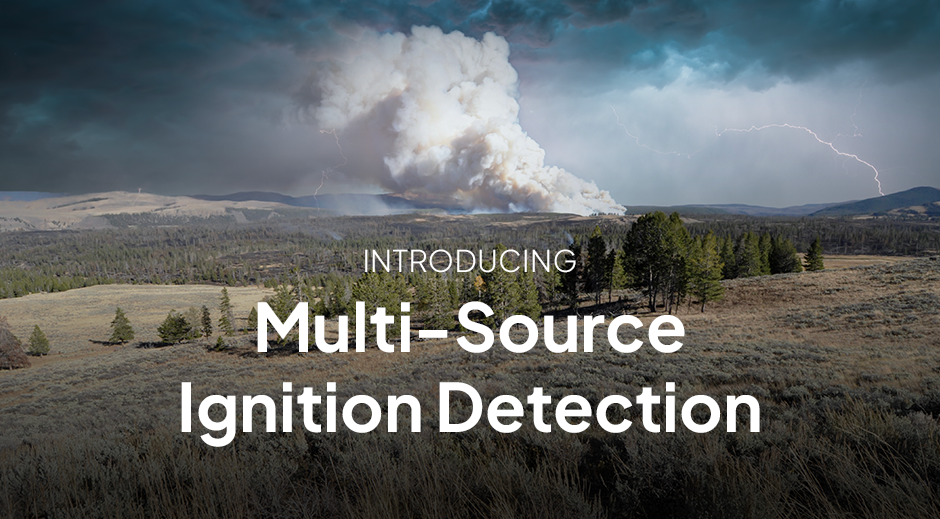
As part of our ongoing mission to improve community wildfire resilience around the world, AEM has added a new feature to our flagship AEM Elements® 360 environmental monitoring and decision support application: Multi-Source Ignition Detection.
Multi-Source Ignition Detection represents a significant step forward in early-stage wildfire detection capabilities by combining a variety of real-time data sources with AI to transform AEM Elements 360 into an even more powerful multi-hazard decision support hub.
Moving forward, we’ll…
- Define Multi-Source Ignition Detection
- Explore how Multi-Source Ignition Detection improves outcomes
- Share how can you get a custom demonstration of multi-source ignition detection in action
What is Multi-Source Ignition Detection?
Multi-Source Ignition Detection is the process of cross-referencing real-time information from a variety of in-field sensors and data sources to identify or confirm a potential wildfire ignition. By combining high-resolution PTZ camera imagery, lightning detection, satellite data, and wildfire weather monitoring, multi-source ignition detection provides a clear, 360-degree picture of a potential wildfire ignition as it unfolds
Some examples of relevant data sources from the field include:

- Live camera feeds: Pan-tilt-zoom (PTZ) cameras offer key visual intelligence from the field, and AI smoke detection provides the perfect trigger for your assessment/confirmation protocol.
- Fire weather networks: Data from Remote Automated Weather Stations (RAWS) can help you identify areas of increased wildfire risk or assess how wind and weather are impacting fire behavior in real time.
- Lightning detection networks: Real-time alerts for local lightning strikes from the Earth Networks Total Lightning Network® help you identify potential ignition sources and make intelligent decisions about how to use camera and human resources.
- Air quality data: Air Quality Index (AQI) reflects particulate air pollution from wildfire smoke, which means a local air quality sensor or feed can help confirm visual smoke detection or identify potential fires outside the camera viewshed.
- Satellite hotspots: Satellites provide a sky-high thermal view of the wildlands, making it possible to detect and assess ignitions in extremely remote locations or areas beyond the view of conventional monitoring.
What’s so powerful about Multi-Source Ignition Detection for wildfires?
Multi-Source Ignition Detection is the best possible strategy for identifying wildfire hazards because it both decreases false alarms and increases early-stage intelligence to support mitigation. It provides wildfire and public safety leaders with more data while also reducing the time it takes to make a decision and act accordingly. That means better, more decisive outcomes and a safer public.
How increasing data sources reduces false alarms
When you rely on just one source of truth to identify a potential wildfire, you leave yourself open to both false alarms and undetected ignitions.
What looks like smoke visually could be fog or steam or industrial output. A cluster of lightning strikes could look impressive but completely miss potential fuel. When you deploy personnel to respond to those false alarms, you’re wasting time and money, while leaving yourself vulnerable to an actual wildfire occurring elsewhere during that false-alarm response. On the other hand, you could be so focused on that one lightning map or camera that you miss something an alternate means of intelligence would've detected easily - with potentially catastrophic results.
Multi-Source Ignition Detection provides a framework to rapidly ingest and cross-reference a wider range of reliable data sources from the field, reducing the false alarms and coverage gaps created by the limitations of each individual kind of sensor.
How combining data sources streamlines ignition detection
Multi-Source Ignition Detection significantly speeds up the process of detecting, assessing, and responding to a potential wildfire ignition by breaking the traditional silos between data sources to present wildfire leaders with all the data they need to make an informed decision in a single window.
By eliminating the need to launch and manage multiple software interfaces during crucial early-stage moments in the development of a wildfire, Multi-Source Ignition Detection reduces the number of minutes and seconds needed to make a preliminary remote assessment and deploy a team of response professionals as needed.
Learn more about AEM Elements 360’s wildfire features
There are a growing number of wildfire solution providers on the market, but AEM and our family of brands are proud to be the true cornerstones of this space. Our Multi-Source Ignition Detection framework combines the best elements of intelligent automation and traditional human monitoring. The automated alerts serve as a trigger to tap the irreplaceable expertise of human wildfire experts in a way that accelerates action when it’s needed most while protecting monitoring professionals from the frustration and waste of false alarms.
If you’re interested in learning more about how we are helping wildland firefighting agencies and communities around the world build resilience through improved data clarity and increased confidence, it’s time to schedule a detailed personalized demo of AEM Elements 360.